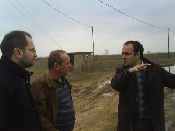WP5.4 Remediation recommendations
Documents and reports relating to WP5.4 Remediation recommendations
Documents
 WP5.4 A list of recommended remediation strategies within each region
WP5.4 A list of recommended remediation strategies within each region
Authors: Mark Reed, Luuk Fleshens and Lindsay Stringer
Summary of findings from the final stakeholders workshops at which evidence from field trials and models was reviewed. This information is used to prioritise remediation strategies for regional dissemination. (Report 95 D5.4.1 Apr12)
 WP5.4 A methodological approach and modelling tool to evaluate desertification remediation options
WP5.4 A methodological approach and modelling tool to evaluate desertification remediation options
This report presents a hybrid methodological framework that builds primarily upon the DESIRE project. To ensure that the approach is as widely applicable as possible beyond this original context, this report describes how the DESIRE methodological framework has been combined with approaches developed by UN Food & Agriculture Organisation’s Land Degradation Assessment in Drylands (LADA), the World Overview of Conservation Approaches and Technologies (WOCAT) programme and the Dryland Development Paradigm (DDP). This was done as part of a process facilitated by the UNCCD’s Committee on Science & Technology and has informed discussion on knowledge management within the Convention. The framework suggests that monitoring and assessment should determine the progress of SLM towards meeting sustainability goals, with results continually and iteratively enhancing SLM decisions. (Report 97 D5.4.2 May12)

Acknowledgement
The DESIRE project was
|
DESIRE brought together the expertise of
26 international research institutes
and non-governmental organisations.
This website does not necessarily
represent the opinion of the
European Commission. The European
Commission is not responsible for
any use that might be made of the
information contained herein. 
